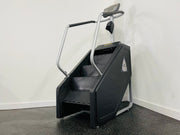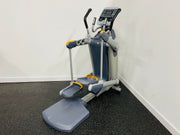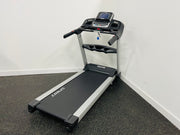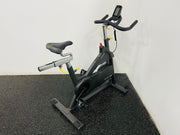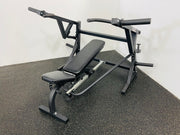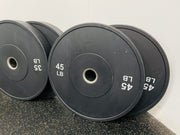Choosing between a treadmill and an exercise bike for your home gym significantly impacts your fitness journey. Both machines offer unique benefits and cater to different preferences and goals. This guide delves into each equipment type, exploring their variations, advantages, disadvantages, space requirements, fat-burning efficiency, exercise versatility, targeted muscle groups, and calorie expenditure during a one-hour workout. Additionally, we'll reference scientific studies highlighting the health benefits of each, ensuring you make an informed choice.
Types of Treadmills and Exercise Bikes
Treadmills come in various forms:
-
Manual Treadmills: Powered by your movement, offering a more intense workout.
-
Motorized Treadmills: Equipped with adjustable speed and incline settings for varied training.
-
Folding Treadmills: Designed to save space, it is ideal for home gyms with limited room.
-
Commercial Treadmills: Robust machines with advanced features suitable for heavy use.
Exercise Bikes also have diverse types:
-
Upright Bikes: Mimic traditional outdoor bicycles, engaging core and lower body muscles.
-
Recumbent Bikes: Feature a reclined seating position, providing back support and reduced joint strain.
-
Spin Bikes: Designed for high-intensity training, closely resembling road cycling.
-
Air Bikes: Utilize air resistance, increasing intensity as you pedal harder.
Pros and Cons
Pros:
-
High-Calorie Burn: Running on a treadmill can burn significant calories, aiding in weight loss.
-
Versatility: Suitable for walking, jogging, and running, with adjustable inclines to simulate various terrains.
-
Bone Density Improvement: Weight-bearing nature helps enhance bone strength.
Cons:
-
Joint Impact: High-impact exercise that may strain joints, posing a risk for individuals with joint issues.
-
Space Requirements: Typically larger and require more room, which could be a limitation in compact home gyms.
-
Cost: Quality treadmills can be expensive, with additional maintenance needs over time.
Exercise Bikes:
Pros:
-
Low-Impact: Gentle on joints, making them suitable for individuals with arthritis or recovering from injuries.
-
Compact Design: Generally occupies less space and is ideal for smaller areas.
-
Lower Body Strengthening: Effectively target quads, hamstrings, calves, and glutes.
Cons:
-
Lower Calorie Burn: Typically burn fewer calories per minute compared to treadmills, potentially making them less effective for weight loss.
-
Limited Muscle Engagement: Primarily focus on the lower Body, offering minimal upper body workout.
-
Monotony: Some users may find stationary cycling less engaging over time.
Space Considerations
Due to their size, treadmills, especially non-folding models, often require a dedicated space. Ensure your home gym can accommodate the treadmill's footprint, including additional clearance for safety.
Exercise Bikes are generally more compact and can fit into smaller spaces. Recumbent bikes may need more room due to their extended design, but upright and spin bikes are typically space-efficient.
Fat-Burning Efficiency
Both machines contribute to fat loss, but their efficiency varies:
-
Treadmills: Running at 5 mph can burn approximately 288 calories in 30 minutes for a 155-pound individual.
-
Exercise Bikes: Cycling at 12 mph burns about 288 calories in 30 minutes for the same individual.
However, either machine's high-intensity interval training (HIIT) can significantly boost calorie expenditure.
Exercise Versatility
Treadmills offer various workouts, including walking, jogging, running, and incline training, and they allow users to simulate different terrains and intensities.
Exercise Bikes provide options like steady-state cycling, HIIT, and resistance training by adjusting pedal resistance, catering to various fitness levels.
Targeted Muscle Groups
Treadmills primarily engage:
-
Lower Body: Calves, hamstrings, quadriceps, and glutes.
-
Core Muscles: Stabilizers activated during movement.
-
Upper Body: Arm swing contributes to overall muscle engagement.
Exercise Bikes focus on:
-
Lower Body: Quadriceps, hamstrings, calves, and glutes.
-
Core Muscles: Engaged for stabilization, especially during intense cycling sessions.
Calorie Comparison for a One-Hour Workout
Calorie burn depends on intensity, individual weight, and workout type:
-
Treadmill: Running at a moderate pace can burn approximately 576 calories per hour for a 155-pound person.
-
Exercise Bike: Moderate cycling burns about 504 calories per hour for the same individual.
Incorporating HIIT can increase these numbers for both machines.
Health Benefits and Scientific Insights
Treadmills:
-
Cardiovascular Health: Regular use enhances heart health and endurance.
-
Bone Density: Weight-bearing exercise strengthens bones, reducing osteoporosis risk.
-
Joint-Friendly: Low-impact nature minimizes joint stress and is suitable for rehabilitation.
-
Cardiovascular Fitness: Improves heart health and endurance with consistent use.
Which Machine Fits Your Fitness Goals?
Choosing between a treadmill and an exercise bike for your home gym depends on your fitness goals, space availability, and physical considerations. If you aim for higher calorie burn and bone-strengthening benefits, a treadmill may be preferable. Conversely, for a low-impact workout that is gentle on the joints and requires less space, an exercise bike is advantageous. Assess your individual needs to select the equipment that best aligns with your health objectives.

